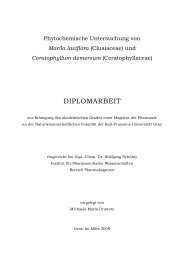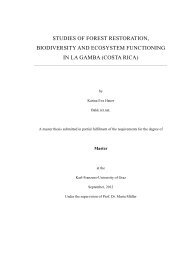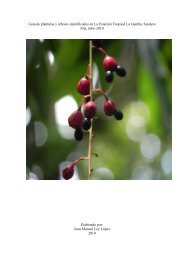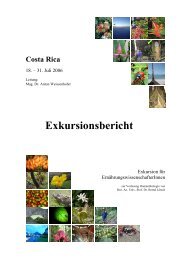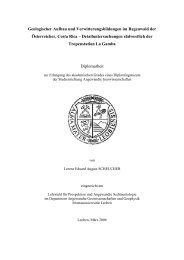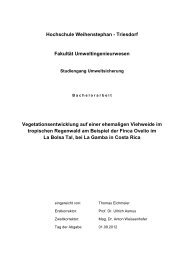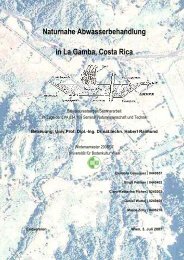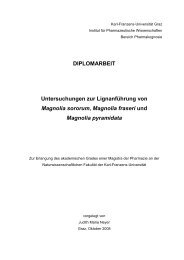Leaf colour patterns, vegetative and sexual reproduction of Episcia ...
Leaf colour patterns, vegetative and sexual reproduction of Episcia ...
Leaf colour patterns, vegetative and sexual reproduction of Episcia ...
You also want an ePaper? Increase the reach of your titles
YUMPU automatically turns print PDFs into web optimized ePapers that Google loves.
Results: The results are listed in table 3. The P/O ratio <strong>of</strong> <strong>Episcia</strong> lilacina is 36,34 : 1.<br />
Table 3 Results concerning the P/O ratio.<br />
Bud number<br />
Number <strong>of</strong> pollen<br />
grains<br />
Number <strong>of</strong> ovules P/O<br />
1 40120 1052 38,14<br />
2 34528 1046 33,01<br />
3 40560 1082 37,49<br />
4 35080 956 36,70<br />
5 35414 974 36,36<br />
Average value 36,34 (±1,99)<br />
Discussion: Pollen-ovule ratios are correlated with the breeding systems <strong>of</strong> plants (Cruden<br />
1977). They reflect pollination efficiency, i.e. the likelihood <strong>of</strong> a pollen grain reaching a stigma<br />
(Cruden <strong>and</strong> Miller-Ward 1981). Cruden (1977) divided the ratios <strong>of</strong> different plants into five<br />
classes <strong>of</strong> reproductive systems: xenogamy (P/O about 5800:1), facultative xenogamy (about<br />
800), facultative autogamy (about 170), obligate autogamy (about 30) <strong>and</strong> cleistogamy (about 5).<br />
The evolutionary shift from class to class is accompanied by a significant decrease in the mean<br />
P/O. The more efficient the transfer <strong>of</strong> pollen, the lower the P/O. That means for <strong>Episcia</strong> lilacina<br />
that about 36 pollen grains come on one ovule. Due to Cruden (1977), this result would indicate<br />
obligate autogamy. A much higher P/O ratio would be expected. Mistakes can <strong>of</strong> course not be<br />
excluded entirely. But even if the result <strong>of</strong> the pollen grain count would be twice as high the next<br />
class would be barely reached. The P/O ratio results <strong>of</strong> this work do not fit in the system <strong>of</strong><br />
Cruden because obligate autogamy <strong>of</strong> <strong>Episcia</strong> lilacina can be definitively excluded.<br />
Examining the amount <strong>of</strong> pollen grains <strong>and</strong> ovules it is obvious that a lot <strong>of</strong> ovules (averagely<br />
1022 ovules) were developed in one gynoecium. Comparing this fact with the high amount <strong>of</strong><br />
pollen grains the low P/O ratio seems to be more comprehensible. The numerical amount <strong>of</strong><br />
pollen grains <strong>and</strong> ovules were not further considered by Cruden (1977). This circumstance makes<br />
comparisons between the results <strong>of</strong> <strong>Episcia</strong> lilacina <strong>and</strong> other plant families difficult.<br />
Nevertheless, many different factors may influence the pollen-ovule ratio (Preston 1986), for<br />
example:<br />
• Enlargement <strong>of</strong> the stigma area; it can receive more pollen grains despite <strong>of</strong> a<br />
constant pollen-transfer area on the pollinator (Cruden <strong>and</strong> Miller-Ward 1981).<br />
65



